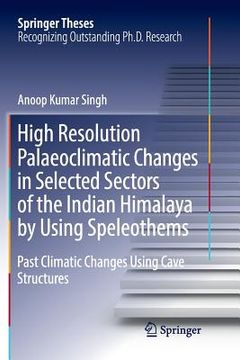Share
High Resolution Palaeoclimatic Changes in Selected Sectors of the Indian Himalaya by Using Speleothems: Past Climatic Changes Using Cave Structures (in English)
Anoop Kumar Singh
(Author)
·
Springer
· Paperback
High Resolution Palaeoclimatic Changes in Selected Sectors of the Indian Himalaya by Using Speleothems: Past Climatic Changes Using Cave Structures (in English) - Singh, Anoop Kumar
$ 104.20
$ 109.99
You save: $ 5.79
Choose the list to add your product or create one New List
✓ Product added successfully to the Wishlist.
Go to My WishlistsIt will be shipped from our warehouse between
Monday, June 24 and
Tuesday, June 25.
You will receive it anywhere in United States between 1 and 3 business days after shipment.
Synopsis "High Resolution Palaeoclimatic Changes in Selected Sectors of the Indian Himalaya by Using Speleothems: Past Climatic Changes Using Cave Structures (in English)"
This thesis encompasses a study of past precipitation patterns based on six cave stalagmites from different parts of the Indian Himalaya. This is the first speleothem study in the Indian Himalaya that shows a direct relationship between past precipitation and the collapse of civilization. The stalagmites examined were KL-3 from Jammu and Kashmir; TCS and BR-1 from Himachal Pradesh; and DH-1, SA-1 and CH-1 from Uttarakhand. Based on the high-resolution palaeoclimatic reconstruction (35 U/th dates, 5 AMS dates, 1,500 samples for δ18O and δ13C values) obtained for the duration of the Pleistocene-Holocene transition (16.2-9.5 ka BP) and Mid-Holocene-Present (ca. 4.0 ka BP-Present), three major events were identified, namely the Older Dryas (OD), B lling-Aller d (BA) period and Younger Dryas (YD) at ca. 14.3-13.9, 13.9-12.7 and 12.7-12.2 ka BP, respectively. The study showed a gradual reduction in the precipitation from 4 ka BP onwards for about a millennium with a peak arid period between 3.2 and 3.1 ka BP. According to the findings, the LIA (Little Ice Age) covers a time span from 1622-1820 AD, during which the climate was wetter than that in the post-LIA period (1820-1950 AD). In addition, this thesis supports the assumption that the WDs (Western Disturbances) contribute significantly to the total rainfall in the Himalaya region.
- 0% (0)
- 0% (0)
- 0% (0)
- 0% (0)
- 0% (0)
All books in our catalog are Original.
The book is written in English.
The binding of this edition is Paperback.
✓ Producto agregado correctamente al carro, Ir a Pagar.

